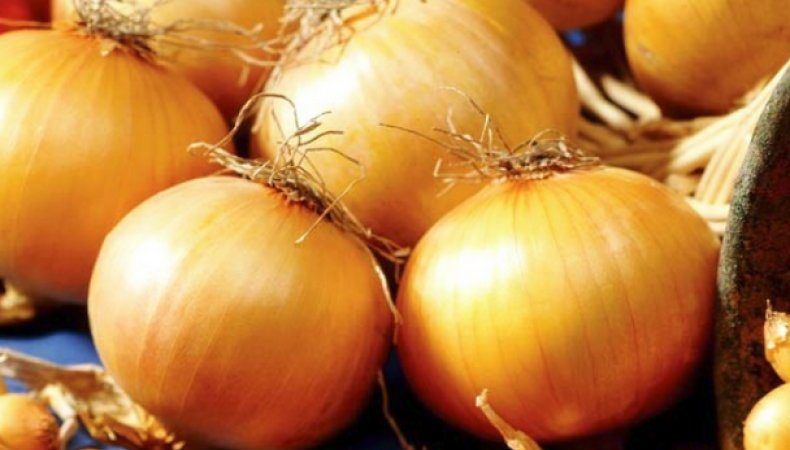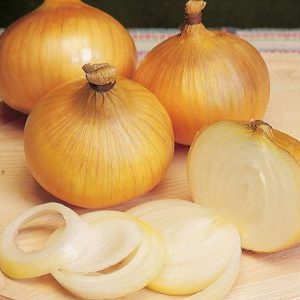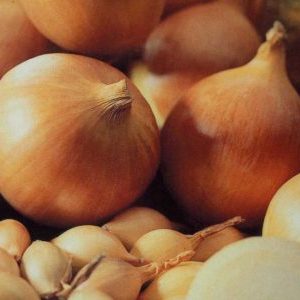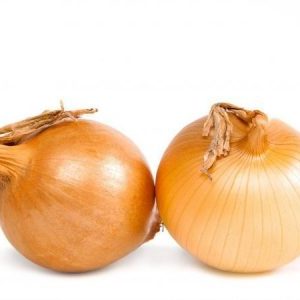High-yielding onion hybrid with amazing taste - "Centurion"
The Centurion onion came to Russia from Holland and quickly gained popularity among domestic farmers. Vegetables have a rich taste and bright aroma, they contain many useful substances, are universal in use. The culture is unpretentious in care, high-yielding. The bulbs fully ripen after ripening and are stored for a long time.
The content of the article
Description of the hybrid
Centurion is a first generation heterotic hybrid. His bulbs are suitable for fresh consumption, additions to seasonings and sauces, preserves and dishes requiring boiling, stewing or frying.
Origin and development
Centurion is a hybrid of Dutch selection, originator is BEJO ZADEN B.V.
Culture was included in the State Register of Russia in 2006.
Composition and useful properties
The onion contains:
- vitamins of group B, C, PP, E;
- fluorine;
- iron;
- iodine;
- zinc;
- phytoncides;
- Sahara;
- essential oils;
- organic acids.
The vegetable has antimicrobial and antiviral effects, normalizes digestion, improves immunity, lowers blood pressure, blood sugar and cholesterol levels.
Ripening period, yield and immunity
This medium early onion ripens within 90 days. Marketable yield - 252-420 c / ha, maximum - 580 c / ha.
Centurion is resistant to downy mildew and cervical rot, but is affected by powdery mildew and Alternaria.
Specifications
The plant forms dark green tubular leaves 80 cm high. Bulbs are single- or double-edged, broadly ovate, weighing 110-150 g each, covered with 3-4 scales of brown-golden color. The pulp is white, the taste is spicy.
For which regions is it suitable
The hybrid is included in the State Register for the Central Region, but taking into account the peculiarities of the climate when landing and growing onions are cultivated in all regions of the country.
Main advantages and disadvantages
Hybrid advantages:
- high productivity;
- pleasant taste;
- good commercial qualities;
- lack of shooting;
- long-term storage;
- the ability to grow in different climatic conditions;
- good seed germination and seed germination;
- immunity to disease;
- resistance to drought, an abundance of precipitation and sharp temperature fluctuations.
The disadvantages of onions include the need for an annual purchase of seeds or sets.
Differences from others
Comparison of Centurion with other hybrids and onion varieties is presented in the table:
| Name | Ripening period | Productivity, c / ha | Bulb shape | Bulb weight, g | Taste |
| Centurion F1 | Mid-early | 252–420 | Broadly ovate | 110–150 | Acute |
| Lamika F1 | Mid-season | 302–341 | Broadly ovate | 90–100 | Semi-sharp |
| Siberia | Early ripe | 219–530 | Wide elliptical | 80–100 | Semi-sharp |
| Albion F1 | Mid-season | 167–220 | Rounded | 70–100 | Semi-sharp |
Planting and growing
Centurion is an onion with a two-year growing cycle. In the first year, sowing is carried out, in the second, sevok is planted, which gives a crop of full-fledged turnips.
Reference! The hybrid is suitable for both spring and winter planting.
Training
Previously, the seeds are soaked in a light solution of potassium permanganate or warm water with the addition of growth stimulants, then wrapped in a cloth and left for 3 days at room temperature until small shoots appear.
Sevok is chosen no more than 2 cm in diameter... Suitable dry specimens without damage, rot and unpleasant odor, covered with straw-colored husks. Before planting, onions are disinfected with a solution of copper sulfate (1 tsp of substance per bucket of water) and heated at a temperature of + 30 ... + 40 ° C.
The land on the site is dug up in advance, cleaned of weeds and plant residues, wood ash, manure or potassium-phosphorus fertilizers are applied to reduce acidity and enrich with nutrients. Peat and sand are added to clay soil.
Ground requirements
Hybrid prefers light fertile soil, which is good for moisture, air and has a neutral acidity level.
Timing, scheme and landing rules
For growing seedlings, sowing is carried out directly into open ground or small boxes, containers. This is done in late February and early March, deepening the seeds by no more than 3 cm, keeping a distance of 10 cm between them.
Pre-hardened seedlings are dived into the ground from mid-April to early May, when the ground warms up to at least + 15 ° C at a depth of 12-15 cm.
Pick scheme:
- In the prepared area, grooves are made up to 4 cm deep, leaving 20-25 cm between them.
- Landing grooves are made in the furrows every 10-15 cm.
- Water the soil abundantly with warm water.
- The seedlings are removed from the containers and placed in the holes.
- They are covered with earth and slightly compacted.
Sevok is planted in spring or before winter, about 2-3 weeks before the first frost.
Planting scheme for onion sets Centurion:
- Furrows are prepared 4 cm deep at a distance of 25–30 cm from each other.
- Water them with warm water.
- The bulbs are planted in furrows every 10 cm, deepening by 3-4 cm.
- Sprinkle with earth on top, tamp it a little.
Growing features
Centurion onion develops well at a temperature of + 12 ... + 16 ° C, bright and continuous lighting and abundant watering at the beginning of active growth.
The optimal place for culture is an open sunny area, protected from strong winds and drafts.
The Centurion is not planted in the same place more often than 1 time in 3 years. Best predecessors: tomatoes, cucumbers or potatoes.
The nuances of care
Get a bountiful harvest of onions with proper care.
Watering mode
After planting the seedlings in the ground and until the end of June, the culture is watered often and abundantly, about once a week. The approximate water consumption is 8 liters per 1 m2.
With the beginning of the formation of bulbs, irrigation is reduced, and 3 weeks before harvesting, they stop completely.
Loosening and weeding
After each moistening, or at least once every 10 days, the soil is loosened to avoid the formation of a crust on the surface and to improve the access of oxygen, moisture and nutrients to the bulbs.
They are weeded out as the weed grows, which deprives the culture of nutrients, provokes rotting of vegetables and attracts pests.
Top dressing
Fertilization scheme:
- 14 days after germination - mineral fertilizers (ammonium nitrate, superphosphate or potassium chloride diluted in water);
- after 2 weeks - organic matter (1 liter of manure is taken for 5 liters of water, infused for 2-3 weeks, diluted with water 1: 6).
The third feeding is optional. If it is carried out, then complex preparations are used: for example, nitrophoska (2 tablespoons per 10 liters of water).
Important! It is recommended to apply fertilizers in liquid form, as dry plants burn.
Disease and pest control
If the plants are affected by powdery mildew, they cannot be saved. This disease is prevented by preventive treatment of plantings with fungicides. They are also used in the development and for the prevention of Alternaria.
Among the pests, the Centurion is attacked by onion moths and flies, against which insecticides are used.
As a preventive measure against planting damage, the rules of crop rotation are observed, and soil moisture is monitored.
Harvesting and storage
The cessation of the growth of new leaves and the wilting of old ones serve as a signal of the ripeness of the crop.
The onions are harvested in the second half of July, in hot, dry weather, by carefully pulling the turnips out of the ground.
Storage features and keeping quality
The collected bulbs are examined and sorted, discarding any damaged specimens. After they are dried in a shaded place for 2-3 days, the withered feathers are cut off, leaving the tip 4-5 cm long.
By the way! The centurion ripens 100% after ripening.
Vegetables are kept in a dark, well-ventilated and dry place at a temperature of + 1 ... + 3 ° C. If the storage rules are observed, the crop does not deteriorate for 6 months or more.
Growing difficulties
Problems that farmers face when cultivating Centurion:
- rotting onions with high soil moisture;
- secondary growth of culture in case of untimely harvesting;
- slow development and poor growth of bulbs when planting vegetables in soil with high acidity.
Tips from experienced gardeners
Farmers recommend:
- store the crop in sand: this way it spoils less;
- when growing onions on a feather, after each cut, feed the plantings with nitrogen fertilizers: they stimulate the growth of green mass;
- do not fertilize vegetables with fresh manure: it attracts pests;
- plant dill next to onions to repel harmful insects.
Reviews
Gardeners speak about the Centurion bow mostly positively:
Anton, Bryansk region: “For several years now I have been planting Centurion onions, I like its taste and keeping quality. However, there is also a rather significant disadvantage: it is difficult to predict what the harvest will be. Last year, productivity was beyond praise, I even sold a part of the vegetables, but about 3 years ago there were almost no onions: the heads are very small, ugly, a lot of spoiled. Perhaps the weather affected, because he looked after the plantings, as always. "
Natalia, Kostroma region: "Last year was a dry summer, but the harvest, despite this, was excellent. Of course, we took care of the plantings: watered them, fed them, but still the weather usually affects. I like onions to taste: spicy, we just love that. Keeping quality is excellent, vegetables are stored for at least six months. "
Vladimir, Oryol region: “I always had to read the description of varieties, reviews, look at photos in order to choose the optimal crop for planting, until I came across the Centurion hybrid. I have been planting him for 3 years, but he has never failed. I grow seedlings from seeds, seedlings from them, and then large bulbs. This, of course, takes a lot of time, but it's worth it: the yield is excellent, the onions are tasty, they are stored for a long time. "
Conclusion
The result of Dutch selection, the Centurion onion, has firmly taken its place in the private plots and farms of Russia. This hybrid is suitable for cultivation in all regions of the country, is characterized by high yield, excellent commercial qualities and high keeping quality during storage.